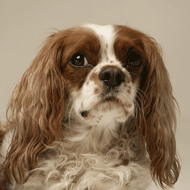
A new study suggests Chiari malformation (CM) can cause significant pain in dogs, as well as changes to activity levels, temperament and sleep.
Professor Clare Rusbridge, of Fitzpatrick Referrals, was inspired to carry out the research to address a lack of clarity over the clinical signs of CM, as opposed to syringomyelia (SM).
CM is an abnormality of the skull which impacts the brain, altering the flow of cerebrospinal fluid. This results in pain and a collection of fluid pockets in the spinal cord (commonly known as SM). Over time, these pockets can cause irreversible damage to a dog’s spinal cord.
It is not clear whether the signs of pain in affected dogs is down to CM or SM, or both.
Prof Rusbridge studied medical records from the past five years, from all Cavalier King Charles spaniels that were presented to her at Fitzpatrick Referrals and diagnosed with CM-associated clinical signs.
Common signs in all dogs were vocalisation, spinal pain (neck, middle or lower back), reduced activity, reduced ability to climb stairs or jump, aversion to being touched or groomed, altered emotional state and sleep disturbances.
A tendency to rub or scratch at the head or ears was common, but more likely to be seen in dogs with small or no SM, suggesting this could be a sign of head discomfort associated with CM. Head and ear rubbing was not associated with the presence of material within the middle ear, a condition that is also common in the breed.
The only signs that were specific to SM were phantom scratching, scoliosis and weakness. These were only present when the SM was at least 4mm wide.
Fitzpatrick Referrals said the study findings are important because they suggest that CM alone is a cause of pain in many dogs. The aim is to use the findings to develop a questionnaire to determine the risk of CM and monitor the response to clinical signs.
Image © Fitzpatrick Referrals



 The RCVS has announced a new version of its 1CPD mobile app, with enhanced features for veterinary surgeons and veterinary nurses to record their continuing professional development.
The RCVS has announced a new version of its 1CPD mobile app, with enhanced features for veterinary surgeons and veterinary nurses to record their continuing professional development.